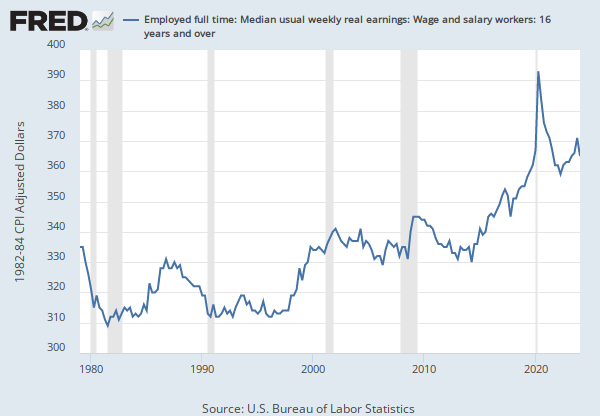Observations
Q4 2024: 1,103 | Dollars, Not Seasonally Adjusted | Quarterly
Updated: Jan 22, 2025 9:03 AM CST
Observations
| Q4 2024: | 1,103 | |
| Q3 2024: | 1,109 | |
| Q2 2024: | 1,071 | |
| Q1 2024: | 1,077 | |
| Q4 2023: | 1,055 |
Units:
Frequency:
Write a custom formula to transform one or more series or combine two or more series.
You can begin by adding a series to combine with your existing series.
Now create a custom formula to combine or transform the series.
Need help?
For example, invert an exchange rate by using formula 1/a, where “a” refers to the first FRED data series added to this line. Or calculate the spread between 2 interest rates, a and b, by using the formula a - b.
Use the assigned data series variables (a, b, c, etc.) together with operators (+, -, *, /, ^, etc.), parentheses and constants (1, 1.5, 2, etc.) to create your own formula (e.g., 1/a, a-b, (a+b)/2, (a/(a+b+c))*100). As noted above, you may add other data series to this line before entering a formula.
Finally, you can change the units of your new series.
Add the minimum, maximum, and average calculations of selected bars to the graph
Write a custom formula to transform one or more series or combine two or more series.
You can begin by adding a series to combine with your existing series.
Now create a custom formula to combine or transform the series.
Need help?
For example, invert an exchange rate by using formula 1/a, where “a” refers to the first FRED data series added to this line. Or calculate the spread between 2 interest rates, a and b, by using the formula a - b.
Use the assigned data series variables (a, b, c, etc.) together with operators (+, -, *, /, ^, etc.), parentheses and constants (1, 1.5, 2, etc.) to create your own formula (e.g., 1/a, a-b, (a+b)/2, (a/(a+b+c))*100). As noted above, you may add other data series to this line before entering a formula.
Finally, you can change the units of your new series.
Add the minimum, maximum, and average calculations of selected bars to the graph
Data in this graph are copyrighted. Please review the copyright information in the series notes before sharing.
Notes
| Title | Release Dates | |
|
|
||
| Employed full time: Median usual weekly nominal earnings (second quartile): Wage and salary workers: 55 years and over: White: Women | 2015-01-21 | 2025-01-22 |
| Source | ||
|
|
||
| U.S. Bureau of Labor Statistics | 2015-01-21 | 2025-01-22 |
| Release | ||
|
|
||
| Weekly and Hourly Earnings from the Current Population Survey | 2015-01-21 | 2025-01-22 |
| Units | ||
|
|
||
| Dollars | 2015-01-21 | 2025-01-22 |
| Frequency | ||
|
|
||
| Quarterly | 2015-01-21 | 2025-01-22 |
| Seasonal Adjustment | ||
|
|
||
| Not Seasonally Adjusted | 2015-01-21 | 2025-01-22 |
| Notes | ||
|
|
||
|
Data measure usual weekly earnings of wage and salary workers. Wage and salary workers are workers who receive wages, salaries, commissions, tips, payment in kind, or piece rates. The group includes employees in both the private and public sectors but, for the purposes of the earnings series, it excludes all self-employed persons, both those with incorporated businesses and those with unincorporated businesses. Usual weekly earnings represent earnings before taxes and other deductions and include any overtime pay, commissions, or tips usually received (at the main job in the case of multiple jobholders). Prior to 1994, respondents were asked how much they usually earned per week. Since January 1994, respondents have been asked to identify the easiest way for them to report earnings (hourly, weekly, biweekly, twice monthly, monthly, annually, or other) and how much they usually earn in the reported time period. Earnings reported on a basis other than weekly are converted to a weekly equivalent. The term "usual" is determined by each respondent's own understanding of the term. If the respondent asks for a definition of "usual," interviewers are instructed to define the term as more than half the weeks worked during the past 4 or 5 months. For more information see https://www.bls.gov/cps/earnings.htm The series comes from the 'Current Population Survey (Household Survey)' The source code is: LEU0252894300 |
2015-01-21 | 2025-01-22 |
Release Tables
Permalink/Embed
modal open, choose link customization options
Select automatic updates to the data or a static time frame. All data are subject to revision.









